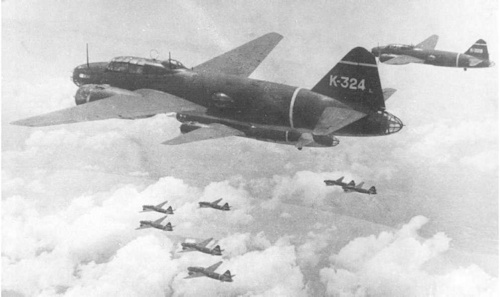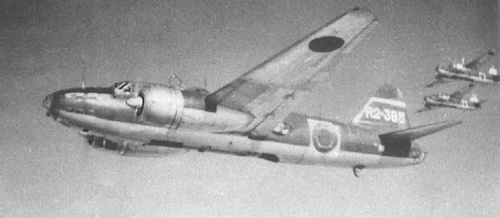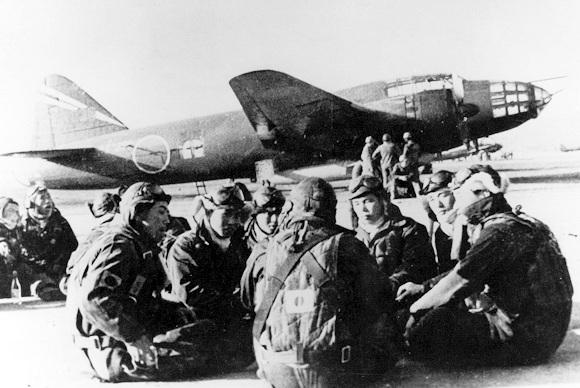The twin engine Mitsubishi G4M, nicknamed by the Japanese Rikko e Betty by the Americans, it was one of the most important bombers of the Japanese Empire in the Second World War.
Ordered at Mitsubishi by the Navy Aviation (but with the mission to operate from land bases), the Mitsubishi G4M it was designed between 1937 and 1939 under the supervision of Kiro Honjo. The first model flew in September 1939, piloted by test pilot Katsuzo Shima, while the second flew the following year.
It should be noted that the Rikko it did not "suffer" particular torments from the point of view of construction, nor was it produced in multiple variations. The first series production was ready in 1941 and the following series (not much modified) were five. A total of 2479 specimens were made.
Il Rikko also named Hammocks (flying cigar due to its fusiform shape) was a vehicle of refined aeronautical conception, endowed with great autonomy, but not capable of carrying a conspicuous war load. It also presented some not insignificant vulnerabilities: having the wing tanks without protection.

Il Mitsubishi G4M it operated in all the theaters of the conflict that saw the armed forces of the Japanese Empire occupied.
Importantly, ai Rikko the Japanese Empire owed many of its early successes, such as the ground destruction of US aircraft based at Clark Airport in the Philippines (performed on December 8, 1941 by some forty Mitsubishi G4M departed from Formosa) and the sinking of the cruiser Repulse and the battleship Prince of Wales (in Malaysian waters on 10 December 1941). Great shame for the Royal Navy.
It should be noted that the great Japanese victory against the British resulted in two main outcomes: on a strictly strategic level, the annihilation of the British naval force freed the Japanese general staff from its most serious torment, thus handing over Malaysia, essentially defenseless important; on the tactical level, however, this success sanctioned the superiority "definitive of aviation on surface ships without air protection. One had been turned naval warfare history page.1
 This double blow inflicted on the Royal Navy opened the doors of its conquests to the Empire of the Rising Sun! In fact, it won one victory after another: Hong Kong, Singapore, Malacca, the Dutch East Indies and Burma. At that moment the Japanese Empire seemed unstoppable.
This double blow inflicted on the Royal Navy opened the doors of its conquests to the Empire of the Rising Sun! In fact, it won one victory after another: Hong Kong, Singapore, Malacca, the Dutch East Indies and Burma. At that moment the Japanese Empire seemed unstoppable.
The bombers Mitsubishi G4M, in this phase of the conflict, they managed to carry out many attacks against targets scattered over a very large area; one may recall those on Port Moresby, the Gilbert Islands, the Marshall Islands and those on US shipping on Guadalcanal.
However, the “honeymoon” did not last long for the Rising Sun bomber… As soon as the United States and its allies were able to completely reorganize the air defenses in the Pacific, the attacks of the Rikko they were held back and controlled so much that from the second half of 1942 the Japanese bombers could no longer afford to operate without a protective escort. Upon returning from each raid, now, the squadrons of Mitsubishi G4M began to decrease significantly.
 Between 1944 and 1945 "flying cigars" were even used to drop flying bombs ohka.
Between 1944 and 1945 "flying cigars" were even used to drop flying bombs ohka.
Il August 19, 1945 two Mitsubishi G4M they landed “in the island of Le Shima bearing the delegation who, in the name of Emperor Hirohito, came to offer surrender".2
Il Rikko it had a wingspan of 24,89 m and a length of 19,63 m. The engines consisted of 2 Mitsubishi MK4T Kasei 25 from 1540/1850 HP each. Armament consisted of 4 x 20mm cannons and one 77mm machine gun.
The offensive load consisted of 1000 kg of bombs or 1 torpedo of 800 kg. The empty weight was 8190 kg, while fully loaded it was about 15.000 kg.
It could reach a maximum speed of 438 km/h at 4600 m. Cruising speed was about 315 km/h at 3000 m. She had range of 3650 km. The ceiling altitude was about 8900 m.
1 B, Millot, The Pacific War 1941-1945. The largest air-naval conflict in history, BUR, Milan, 2019, p.83
2 G. Bonacina, The Mitsubishi G4M “RIKKO”, in Illustrated History n°157, 1970, p.100
Photo: US Navy / web












